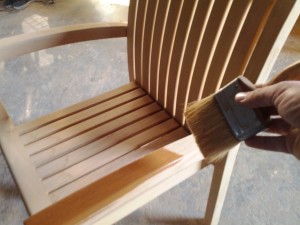Teak Oil vs Teak Sealer: Pros and Cons
When it comes to maintaining the beauty and longevity of your teak furniture or deck, it’s important to know the difference between teak oil and teak sealer. Both products have their pros and cons, and understanding their unique attributes can help you make an informed decision about which one is best for your needs. In this blog post, we’ll discuss when to use teak oil or teak sealer, showcase the different attributes of each item, and provide general application instructions.
What is Teak Oil?
Teak oil is a product that is designed to penetrate the wood and provide a protective barrier against moisture and UV rays. It’s typically made from a blend of linseed oil, tung oil, and other natural oils that help to nourish the wood and enhance its natural beauty.
Pros of Teak Oil
- Enhances the natural beauty of the wood: Teak oil helps to bring out the rich, golden color of teak wood, making it look more vibrant and beautiful.
- Easy to apply: Teak oil is easy to apply with a brush or cloth, and it dries quickly.
- Provides some protection: While teak oil doesn’t provide as much protection as a sealer, it does help to repel water and protect against UV rays.
Cons of Teak Oil
- Requires frequent reapplication: Teak oil needs to be reapplied every few months to maintain its protective properties.
- Can attract dirt and dust: Because teak oil is a penetrating oil, it can attract dirt and dust, which can make your furniture or deck look dirty over time.
- Not as durable as a sealer: Teak oil doesn’t provide as much protection as a sealer, so it’s not as durable in the long run.
Popular Uses for Teak Oil
Teak oil is commonly used on outdoor furniture, such as patio chairs and tables, as well as on indoor furniture, such as dining tables and bookshelves. It’s also popular for use on boats, where it helps to protect against the harsh marine environment.
To apply teak oil, you’ll need a clean cloth or brush, sandpaper, and teak oil. Begin by sanding the surface of the wood lightly to remove any dirt or grime. Next, apply a thin coat of teak oil using a cloth or brush, following the grain of the wood. Allow the oil to soak in for 10-15 minutes before wiping away any excess with a clean cloth. Repeat this process until you achieve the desired level of protection.
What is Teak Sealer?
Teak sealer is a product that is designed to provide a protective barrier on the surface of the wood. It’s typically made from synthetic resins that help to repel water and protect against UV rays.
Pros of Teak Sealer
- Provides long-lasting protection: Teak sealer provides a more durable protective barrier than teak oil, so it lasts longer.
- Easy to maintain: Once applied, teak sealer requires very little maintenance. It can be easily cleaned with soap and water.
- Repels water and protects against UV rays: Teak sealer helps to repel water and protect against UV rays, which can help to prevent fading and discoloration.
Cons of Teak Sealer
- Can alter the appearance of the wood: Because teak sealer sits on the surface of the wood, it can alter its appearance, making it look less natural.
- More difficult to apply: Teak sealer is more difficult to apply than teak oil, and it requires more preparation.
- Can be more expensive: Teak sealer is typically more expensive than teak oil.
Popular Uses for Teak Sealer
Teak sealer is commonly used on outdoor decks and patios, where it provides long-lasting protection against the elements. It’s also popular for use on outdoor furniture, such as lounge chairs and dining sets.
To apply teak sealer, you’ll need a clean cloth or brush, sandpaper, soap and water, and teak sealer. Begin by cleaning the surface of the wood with soap and water to remove any dirt or grime. Next, sand the surface lightly to remove any rough spots or imperfections. Apply a thin coat of teak sealer using a cloth or brush, following the grain of the wood. Allow the sealer to dry completely before applying additional coats if necessary.
In conclusion, both teak oil and teak sealer have their pros and cons, and it’s up to you to decide which one is best for your needs. If you’re looking for a product that enhances the natural beauty of the wood and is easy to apply, then teak oil might be the right choice for you. However, if you’re looking for something that provides long-lasting protection and is easy to maintain, then teak sealer might be a better option.
If you’re in need of professional help with your teak furniture or deck restoration in Orange County or Los Angeles area, contact us today for more information!

